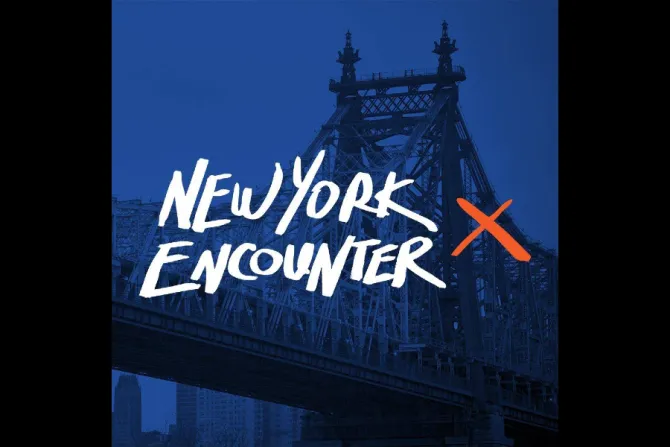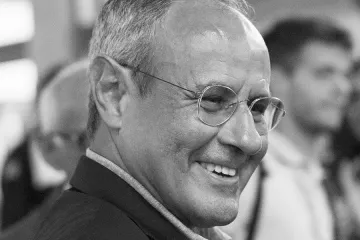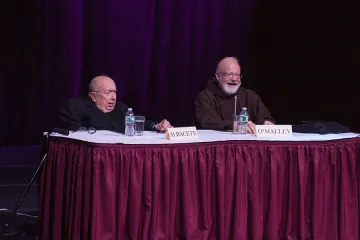Denver Newsroom, Feb 2, 2022 / 13:00 pm
The search for truth in a polarized, pandemic-struck world will be the focus of myriad conversation and artistic events at this year’s New York Encounter, held later this month in New York City.
Cultural commentators, New York Times columnists, and medical experts will join artists, musicians, poets, and ordinary people to consider questions about trust in science, truth in journalism, political polarization, and what we can learn from a Japanese husband and wife who suffered the stresses and the horrors of the Second World War.
The theme of this year's New York Encounter is “This Urge for Truth.” The event will be held in-person Feb. 18-20 at the Metropolitan Pavilion in New York City, with many major panels streamed live on YouTube.
Attendance is free of charge and no registration is required, though attendees must follow New York City Covid-19 restrictions on indoor events.
“Coming to the Encounter means opening up the door to those questions we all too often tend to suppress,” Maurizio Maniscalco, Chairman of New York Encounter, told CNA Feb. 1
“You find people from all walks of life, all ages, you find hundreds of volunteers,” he said. “And all this forces you to ask yourself: What is this life? What’s behind all this?”
The New York Encounter is a cultural event with many aspects: panel discussions on a variety of topics, artist exhibits, musical and poetic performances and other special exhibits. It originated with members of Communion and Liberation, a Catholic lay movement, but it is not an official project of the movement, Maniscalco said.
Maniscalco said the New York Encounter is “an attempt to publicly play (out) our faith, trying to understand and judge what surrounds us, what happens around us.”
“It’s a ‘Catholic event,’ in a true sense: it’s ‘universal,” he said. “We want to follow in St. Paul’s footsteps when he invites us to ‘Test everything and retain what is good’.”
“And there is good in this world, as there are people of good will, from all faiths and beliefs,” Maniscalco said. “By encountering them we learn more about the gift of our own faith and the unquenchable thirst for happiness we are made of.”
The panel discussions will include New York Times columnist David Brooks and former National Institutes of Health director Francis Collins, who will hold a conversation about the erosion of trust in science and its consequences. Former Tennessee governor William Haslam, a Republican, and former U.S. Rep. Dan Lipinski, an Illinois Democrat, will speak about whether politics is a zero-sum game and about how to overcome ideological divides.
Other topics include truth and reconciliation in the U.S. prison system; gender theory and its implications for society; the changing role of the U.S. in global affairs; the challenges of capitalism; Haiti’s humanitarian crisis and its possible futures; health care; and the human immune system and the Covid-19 virus.
Sunday Mass will be celebrated by Archbishop Christophe Pierre, the apostolic nuncio to the U.S. The choir will be directed by Sebastian Modarelli, the music director at the Co-Cathedral of St. John in Rochester, Minn.
Among the final events is a Sunday evening presentation on Dr. Takashi Nagai and his wife Midori Mirayama, who lived in mid-twentieth century Japan.
Nagai was a convinced atheist but his reading of the French thinker Blaise Pascal led him to seek out Catholic Christianity. His experience of the Mass and his encounter with Midori’s example of faith and purity of heart led to his conversion to Catholicism, despite opposition from his father and other social pressures, according to their biography on the website of the association Friends of Takashi and Midori Nagai.
(Story continues below)
In the late 1930s he showed surprising bravery and charity as a medical doctor for the Japanese army in Manchuria, even though he was shocked by the brutality his fellow soldiers sometimes committed. He put his life at risk to secure medical supplies for his patients and even rescued wounded Chinese soldiers and secured supplies for them.
“Nagai’s story is the story of a man found by Christ through the encounter with a girl: Midori, who eventually became his wife,” Maniscalco told CNA. “It’s the story of his dedication to Christ through his work as a medical doctor in a bleeding Japan, his tireless work and testimony of faith, hope and love.”
Midori was a teacher and community leader, descended from the “hidden Christians” who preserved Catholic Christianity in Nagasaki. She wrote to Takashi and sent him a catechism during his service in the military. She married him knowing the health risks of his career as a radiologist, and indeed he developed cancer in early 1945. They had four children together, two of whom died in infancy.
Takashi survived the atomic blast from the Americans’ Aug. 9, 1945 attack on Nagasaki, and labored for two days to take care of survivors. Midori was not among them. Her husband returned to home to find their house devastated. He found only a few charred bones of his wife, next to her twisted, broken metal rosary.
He continued to help survivors and survived a serious wound after praying to St. Maximilian Kolbe, whom he had known from the Polish priest’s time in Japan. The doctor sought to live in hope and faith, encouraging survivors to “to walk the path of the beatitudes.” Despite his continuing cancer, he labored to rebuild Nagasaki and planted 1,000 cherry trees. He lived a life of poverty and prayer, writing books and letters when his declining health prevented other work.
Takashi Nagai died on May 1, 1951, admired by the people of Nagasaki and by many personalities around the world as “the saint of Urakami.”
For Maniscalco, the lives of this married couple help people know “that holy people exist, that the gift of faith brings hope and love even when an atomic bomb brings unbelievable devastation.”
Their lives will be presented at the New York Encounter by Gabriele di Comite, president of the Friends of Takahishi and Midori Nagai association; Chad Diehl, a historian at the University of Virginia; and movie director Dominic Higgins.
“We always try to conclude the Encounter with a powerful testimony of sanctity,” said Maniscalco. The 2019 event included testimony from both the husband and medical doctor of Chiara Corbella Petrillo, whose cause for canonization is under investigation. She was an Italian wife and mother of three who died of cancer in 2012 at the age of 28, after living a life known for joy, faith, and love.
“A testimony of sanctity is an invitation to our own conversion and also to a more attentive gaze at those around us,” Maniscalco continued. “We’re all limited human beings, but a testimony of a changed life is stronger than all weaknesses and limitations.”
The pandemic has prompted “radical questions” about suffering, death, meaning, and how people should respond to these questions, Encounter organizers said in a statement.
Efforts to respond to the pandemic also prompted politically polarized answers that invited people “to follow a party line rather than a search for truth.” This situation added to other polarizations over political questions and encouraged the temptation to twist reality to fit our interpretations.
“It seems we live in different worlds, each with its own ‘truths’ that often spare us the hard work of seeking the truth. But at what price?” organizers asked.






